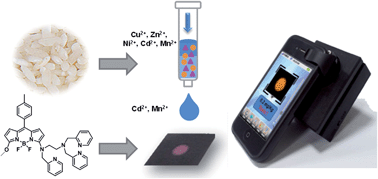An SPE-assisted BODIPY fluorometric paper sensor for the highly selective and sensitive determination of Cd2+ in complex sample: rice†
Abstract
By using sensing technology, the individual component analysis at trace level in complex samples remains problematic simply because of various interfering species. For example, the determination of Cd2+ in rice is difficult due to the co-existing interfering metal cations at thousands or even millions of times higher concentrations. In this study, a heavy-metal ion sensitive BODIPY (4,4-difluoro-4-bora-3a,4a-diaza-s-indacene)-based fluorometric paper sensor with assistance of solid phase extraction (SPE) was developed for the highly selective and sensitive determination of trace Cd2+ in rice. SPE column packed with prepared sulfonated PS–DVB microspheres was employed to enrich trace Cd2+ and meanwhile remove most interfering heavy-metal ions in simulated complex rice sample with oxalic acid as eluent, which was theoretically selected on the basis of f values. Mn2+, as a major coexistent heavy-metal ion, could not be easily removed by SPE, but showed little fluorescent response for BODIPY fluorometric paper sensor even in excess amounts. Combining the separation and enrichment capability of SPE column with the selectivity of BODIPY-based fluorometric paper sensor, we were able to detect trace Cd2+ in complex samples. The response of fluorometric paper sensor was linearly related with Cd2+ concentrations in the range of 0.5–4 μM, with a detection limit of 0.5 μM. Twelve real rice samples spiked with Cd2+ were analysed using this method and the results are in good agreement with ICP-MS measurements.


 Please wait while we load your content...
Please wait while we load your content...